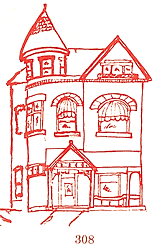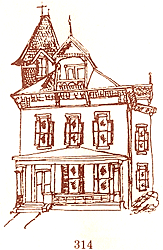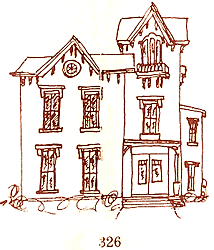 One Click...
One Click...
to all things local!
North 10th Street, A 19th Century Tour
Note: This is the web-based incarnation of a brochure originally published in 1980. While the history is still very valuable, other information may no longer be accurate. Information updated by WayNet will be listed in this orange color.
 308 North 10th Street
308 North 10th Street
This Romanesque/Victorian house built in the 1890's by William P. Hutton contained 19 rooms, three ornate mantels and fireplaces, and an open stairway from the first to the third floor. As with many houses built during this time, it also had hardwood floors with inlaid patterns.
W.P. Hutton was president of the J.M. Hutton Company, casket makers. He was also treasurer of the Richmond Water Works Company.
In or around 1902, Edgar F. Hiatt, then treasurer of the Dickinson Trust Company, bought the home and had it dismantled and moved to 2018 Main Street, the site of the now defunct Red Barn (Red Nails / Sub 'n Roll).
According to research, the structure was dismantled with the stone pieces of the front and sides being numbered for proper reassembly.
In 1905 the ownership transferred to George R. Williams, a bookkeeper at the Gaar, Scott Co.
Gaar Williams, a Richmond native who became a noted cartoonist for the Chicago Tribune, was a son of George R. Williams.
The 308 N. 10th street site was then used, along with the land under the D.G. Reid house for the present Day Care Building.
 314 North 10th Street
314 North 10th Street
A neo-Jacobean/Victorian structure built in the 1870's was the home of Mathew and Emily Hutton Dill. According to research, it is believed that Mrs. Dill's father, Mr. Hutton, had the house built for them.
Mr. Dill was secretary of the J.M. Hutton Co, vice president of Richmond Bridge, and treasurer of the Richmond City Water Works.
Until September of 1977, the house had beautiful stained glass windows in the curved stairway.
 326 North 10th Street
326 North 10th Street
"High Tower" as the home of James M. Starr has become known, was built about 1870 by Elizabeth Starr, Charles W. Starr's widow. The original grant of land from the Federal Government was signed by President James Monroe in 1811. C.W. Starr purchased this land, an area of 240 acres from Jeremiah Cox, in the year 1826 and built a small federal house just to the north of this structure.
The third of ten children, James M. Starr married Lydia C. Briggs who died about three years after their marriage. His second wife was Sarah Jane King, a daughter of Levinus King.
James M. Starr was a prime source of funding for a piano company in 1872 later to become known as, "the house of Starr", Starr Piano Company.
Henry D. Chapin purchased this home and lived there until 1909. Charles and Gertie Klop, their daughter Elizabeth, and son Bert resided there between 1909 and 1925. The Klops boarded and entertained theatrical people who came to Richmond to perform at the Murray Theatre.
Miss Elizabeth continued her dance studio in this home until hear death in 1969.
It is believed that a log cabin stood on the side of this eclectic high Victorian.
| West Side | East Side |
Text and illustrations © 1980, Old Richmond, Inc.
![]()
![]()
![]()
![]()
Location
North 10th Street, Richmond, Indiana between Main and North E Streets.
Hours / Admission
Public Access / Free
Credit
This information was taken from a brochure copyrighted by Old Richmond, Inc. in 1980.
Permission to publish this information was given to WayNet.org by:
Preserve Richmond
P.O. Box 1709
Richmond, IN 47345
Acknowledgements
~Illustrations and Editor -
Lucian A. Szlizewski
~Old Richmond Board of Directors
~Morrisson-Reeves Library
~Ball State University Library
~Earlham College Library
~Palladium-Item
~Original Brochure Printed by The Graphic Press
|
This jQuery slider was created with the free EasyRotator software from DWUser.com.
Need a powerful Flash slideshow creator with built-in iPhone/iPad/Android support? EasyRotator is supported by the XML Flash Slideshow v4 Software. OK |
This jQuery slider was created with the free EasyRotator software from DWUser.com.
Need a powerful Flash slideshow creator with built-in iPhone/iPad/Android support? EasyRotator is supported by the XML Flash Slideshow v4 Software. OK |
|
This jQuery slider was created with the free EasyRotator software from DWUser.com.
Use WordPress? The free EasyRotator for WordPress plugin lets you create beautiful WordPress sliders in seconds. OK |
This jQuery slider was created with the free EasyRotator software from DWUser.com.
Use WordPress? The free EasyRotator for WordPress plugin lets you create beautiful WordPress sliders in seconds. OK |
Featured Member
Community Photo
More Photos:
Wayne County | WayNet Albums
Did You Know?
Wayne County Fast Facts
| Location: | East Central Indiana, USA |
| Founded: | 1810 |
| Population: | 66,456 |
| Elevation: | 1,257 feet Highest Point in Indiana |
| County Seat: | Richmond |
| Local Time: | |
| Date: | |
| About Indiana: | IN.gov |
| Current Weather: |
Follow Us
Contact Us
| Email: | info@waynet.org |
| Phone: | 765.939.0857 |
| Mail: | 50 North 5th St. Richmond, IN 47374 |
| Director: | Board of Directors |
Stay in Touch
Sign up for WayNet News
- our e-newsletter.
Translate This Page
Join WayNet
About WayNet
Waynet, Inc. is a non-profit, 501(c)4 corporation that is fully-funded through memberships. Please support our members and let them know you located them via WayNet.org.
Top 25: popular pages & circulation information.
Our Recent Tweets
Copyright © Waynet, Inc. 2022, All Rights Reserved.| Policies
Directory | News | Discover | Find It Fast | Knowledge | To Do | Members

























